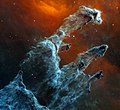Fichier:Pillars of creation - JWST, MIRI - STScI-01GFRYYRTCTMX197BY86MBFCR9.png

Taille de cet aperçu : 656 × 600 pixels. Autres résolutions : 263 × 240 pixels | 525 × 480 pixels | 840 × 768 pixels | 1 120 × 1 024 pixels | 1 987 × 1 817 pixels.
Fichier d’origine (1 987 × 1 817 pixels, taille du fichier : 4,06 Mio, type MIME : image/png)
Historique du fichier
Cliquer sur une date et heure pour voir le fichier tel qu'il était à ce moment-là.
| Date et heure | Vignette | Dimensions | Utilisateur | Commentaire | |
|---|---|---|---|---|---|
| actuel | 29 octobre 2022 à 23:06 |  | 1 987 × 1 817 (4,06 Mio) | Fabian RRRR | Uploaded a work by Credits: SCIENCE: NASA, ESA, CSA, STScI IMAGE PROCESSING: Joseph DePasquale (STScI), Alyssa Pagan (STScI) from https://webbtelescope.org/contents/media/images/2022/053/01GFRYSFM89AFADVAA0W625BSB with UploadWizard |
Utilisation du fichier
Plus de 100 pages utilisent ce fichier. La liste suivante affiche seulement les 100 premières pages qui utilisent ce fichier. Une liste complète est disponible.
- Utilisateur:O Kolymbitès/archive2023
- Discussion utilisateur:A.BourgeoisP/2023-2024
- Discussion utilisateur:A1AA1A
- Discussion utilisateur:Abalg
- Discussion utilisateur:Arcyon37/archive 2023/1
- Discussion utilisateur:Ariel Provost/Archives 2023
- Discussion utilisateur:Bertrouf
- Discussion utilisateur:BerwaldBis
- Discussion utilisateur:Borvan53
- Discussion utilisateur:Bounè rodzo
- Discussion utilisatrice:Bédévore/Archives 2023-Q1
- Discussion utilisateur:Cantons-de-l'Est
- Discussion utilisateur:Chris a liege/arch 23
- Discussion utilisateur:Cobra bubbles/Archive 17
- Discussion utilisateur:ContributorQ
- Discussion utilisatrice:Cymbella/Archive 2023
- Discussion utilisateur:D952
- Discussion utilisateur:Dfeldmann/Archive 15
- Discussion utilisateur:Do not follow/Archive 47
- Discussion utilisateur:Enrevseluj/archives23
- Discussion utilisateur:Erik Bovin
- Discussion utilisatrice:Esprit Fugace/Archive22
- Discussion utilisateur:Exilexi/Archive 2023
- Discussion utilisateur:Fanfwah/Archives/2023
- Discussion utilisateur:Floflo/Archives 2023
- Discussion utilisateur:Frédéric-FR/Archives 2023
- Discussion utilisateur:GabrieL
- Discussion utilisateur:Gemini1980/Archives Q1/2023 à Q2/2023
- Discussion utilisateur:Ghoster
- Discussion utilisateur:Goodshort
- Discussion utilisateur:GrandCelinien
- Discussion utilisateur:GrandEscogriffe/Archive 2023
- Discussion utilisateur:Gratus/Archive 2
- Discussion utilisatrice:Gráinne Ni Mháille
- Discussion utilisateur:HMa
- Discussion utilisateur:Habertix/2023
- Discussion utilisateur:Hadrianus
- Discussion utilisateur:Harrieta171/1
- Discussion utilisateur:Harrieta171/13
- Discussion utilisateur:HistoVG/Archive 3
- Discussion utilisateur:Hégésippe Cormier
- Discussion utilisateur:Io Herodotus/Archive 2021-2023
- Discussion utilisateur:Jack Rabbit Slim's
- Discussion utilisateur:Jean-Paul Corlin
- Discussion utilisateur:JohnNewton8/Archives 2023
- Discussion utilisateur:Jules*/Archive 46
- Discussion utilisateur:Julien1978/Archive 7
- Discussion utilisateur:K.A
- Discussion utilisateur:Kimdime
- Discussion utilisateur:Kirham/Archive 2023
- Discussion utilisateur:L'amateur d'aéroplanes
- Discussion utilisateur:Lagribouille
- Discussion utilisateur:Lebob
- Discussion utilisateur:Lebrouillard/Archive 8
- Discussion utilisateur:Livfornow/Archives 2024
- Discussion utilisateur:Lomita/Archive150
- Discussion utilisatrice:Manacore
- Discussion utilisateur:Mandariine
- Discussion utilisateur:Mathis B/2023
- Discussion utilisateur:Melanthos/Archives/2023
- Discussion utilisateur:Michel421
- Discussion utilisateur:Mike Coppolano/Archive 33
- Discussion utilisateur:Nomen ad hoc/Archive 18
- Discussion utilisateur:O-R/Archive
- Discussion utilisateur:O.Taris
- Discussion utilisateur:O. Morand
- Discussion utilisateur:Olivier Tanguy
- Discussion utilisateur:Oziris
- Discussion utilisateur:Padawane
- Discussion utilisateur:Panam2014
- Discussion utilisateur:Panam2014/2023
- Discussion utilisateur:Passoa15/Archives2023
- Discussion utilisateur:Paul.schrepfer/351-400
- Discussion utilisateur:Pautard
- Discussion utilisatrice:Pierrette13/Archive 11
- Discussion utilisateur:Polmars
- Discussion utilisateur:Racconish/Archive/13
- Discussion utilisateur:Richaringan/Archive 1
- Discussion utilisateur:Ruyblas13/archive2023-1
- Discussion utilisateur:Sammyday
- Discussion utilisateur:SenseiAC
- Discussion utilisateur:Sernin seb-calmetaf
- Discussion utilisateur:Sijysuis/2023
- Discussion utilisateur:Skimel
- Discussion utilisateur:Speculos/2023-1
- Discussion utilisateur:Starus
- Discussion utilisateur:Sunrise156
- Discussion utilisateur:Supertoff/Archives 2023
- Discussion utilisateur:Theoliane
- Discussion utilisateur:Tylwyth Eldar
- Discussion utilisateur:Ælfgar/6649
- Sujet:X9xvaqixq5rjoped
- Sujet:X9xvcjheihqcjyyx
- Sujet:X9xws9lftas45a8g
- Sujet:X9xxpchawrudhhve
- Sujet:X9xy6segp4thrd9k
- Sujet:X9xy7xau3r4o2w09
- Sujet:X9xy8ylb38oz2s4l
- Sujet:X9xyaebeaqg3jubk
- Sujet:X9xybbzyidf8pyxo
Voir plus de liens vers ce fichier.
Usage global du fichier
Les autres wikis suivants utilisent ce fichier :
- Utilisation sur da.wikipedia.org
- Utilisation sur de.wikipedia.org
- Utilisation sur en.wikipedia.org
- Utilisation sur es.wikipedia.org
- Utilisation sur hi.wikipedia.org
- Utilisation sur hu.wikipedia.org
- Utilisation sur ru.wikipedia.org
- Utilisation sur tr.wikipedia.org




